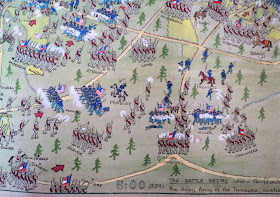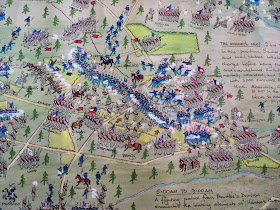It was when commenting in my previous posting, and thinking about 'Pickett's Charge' in terms of time elapsed from the order to attack, to General Armistead's crossing the stone wall into the Union postion, that I was reminded of something I have been meaning to for quite some time. I recalled a National Geographic article in the Gettysburg and Vicksburg centenary issue of National Geographic (Vol 124, Nr 1, July 1963), which showed some very fine maps of the unfolding action.
 |
| Double-plus page spread of Gettysburg, Day One. |
 |
| Detail of the first day's encounter battle. |
 |
| Gettysburg: the second day. |
 |
| Gettysburg: the third day. |
.jpg) |
| Detail of what was to become popularly known as ... Pickett's Charge. |
These images have always been a favorite with me, since seeing this at age 12. I longed to do something of the sort myself. Many, many years later, but so long ago now I don't recall precisely when - early 1980s, I think - I did embark on such a project. And here is the result.
Having read Wiley Sword's (now there's a name!) Shiloh: Bloody April (1974), I meticulously copied, by hand, all the many maps included in the narrative. I highly recommend that book by the way. But as I found it very difficult to follow the overall first day action, I made a kind of combined map. It seemed to me that this map could be given the 'National Geographic' treatment. The following pictures show details from the map, in a vague chronological order as the events unfolded.
 |
| The Confederate Army approaching the somnolent Union Army early of an April morning, 1862. |
Beginning with the bottom left corner, we have the Confederate Army drawn up in successive Army Corps lines, according to the scheme drawn up by General P.G.T. Beauregard. For the purposes of this map, the brigades of each Corps were identified by their flag designs. Hardee (III Corps) had gone for a blue flag with a white roundel or oval; Bragg (II Corps) I issued an early 'Stars and Bars' battle flag; Polk's troops (I Corps) have the flag he designed, and I gave Breckinridge (Reserve Corps) a version of the well-known Beauregard-designed flag.
 |
| Peabody's and Prentiss's stand against the whole Confederate Army |
I have to admit I never did finish the thing properly. I notice now (having looked at this thing for the first time in years), that the flags of Hardee's Corps (really a Division) were neglected. And a few figures were overlooked as well.
I liked the idea of adding, again comme ça National Geographic, a narrative in panels around the map. I could have designed them better, but they do help to follow what's going on, I think.
 |
| Taken by surprise Sherman's Division, later joined by McClernand's is gradually forced back. |
Annoyingly, I too hastily drew the trees in with felt pen, a decision I greatly regret. Nor is there much I can do about it, neither. For the rest, the figures were drawn with water based ink pens...
 |
| The Hornet's Nest. General Ruggles's 64-gun battery can be seen upper left of the picture. |
 |
| Envelopment of the Hornet's Nest position. |
I don't recall how long this thing took to complete - several days, for certain, but whether mostly in one sustained period of time or off-and-on over some weeks, I can't now be sure. Probably the bulk of the thing was dome quickly, and it was finished - for a given value of 'finish' - in a more leisurely fashion. I had no deadlines to fulfil!
 |
| The approach of Lew Wallace's Division from Crump's Landing, off the map to the north. |
Overall, I liked the animated effect that the National Geographic artist achieved, not to mention the style of superimposing the figures upon a much smaller ground scale - just as we do with war games, though I did not know that when I first saw the publication. At any rate, I tried to achieve the same effect here, whilst simultaneously adding a time-lapse effect in the same manner as the Bayeux Tapestry.
 |
| Final stand of Lt. Gen U.S. Grant's Army of the Mississippi, late afternoon, 6 April. |
How effective was it? Well, I was fairly pleased with the overall narrative effect, though a few design glitches presented themselves. Not knowing what the gunboats looked like, I presented them as 'generic' riverine craft. But the main design problems came with the textual narrative.
 |
| The approach of Lt Gen Don Carlos Buell's Army of the Ohio, together with the assistance of the gunboats Tyler and Lexington, saves Gen Grant from total defeat. |
I've had this picture rolled up, stashed away, and almost forgotten for perhaps as many as thirty years now, not really sure what to do with it.




That looks rather excellent. I had great difficulty telling the two apart.
ReplyDeleteYou can lay on the flattery all you like. I'll simply lap it up...
DeleteYou've never shown me that Ion - its superb!
ReplyDeleteI'm surprised I never showed it to you, Paul. I do know Brian O'Sullivan has seen it (about three or four years back, I think). But come to think of it, I don't think many have seen it at all. Having (more or less) completed the thing, I never quite knew what to do with it!
DeleteI'm impressed. Beautiful work and something to be very proud of.
ReplyDeleteWell... :-)
DeleteMy dear Archduke that is absolutely superb! Even though I am a Brit (and we did burn down the White House I believe) I have been fascinated since a child by the ACW and the inspiration for this was largely due to my Dads subscription to National Geographic in the early 1960s. My brother and I have been relighting that war ever since and I think your diagrams are terrific - thanks for posting!!!
ReplyDeleteWow, that is excellent! Takes a lot of work to lay something like that out, draw all the little bits, color and ink it and all. Quite an undertaking. And very nicely done.
ReplyDeleteWhat to do with it? Make copies and sell them!
ReplyDeleteWonderful work.
Btw I agree that Sword`s book was good and a wealth of detail, so much detail that it was easy to lose the thread of the overall picture.
My thanks to The Sun of York, Stryker, Fitz-Badger, Ross Mac for your kind comments. I would respond individually but suddenly the 'Reply' toggle for each of their comments has died (I have no idea why). But I am very gratified by the enthusiasm of your remarks.
ReplyDeleteCheers,
Ion
I always enjoy seeing the fruits of your artistic talents. That map is simply awesome! You should by the way consider Ross Mac's suggestion - I have no doubt that copies would sell well
ReplyDeleteOh, good: the 'Reply' thing is functioning again.
DeleteThanks for you comment, Brian. You might recall, though, that the thing is nearly two foot from side to side, and over 16-inch top to bottom, not counting the margins. For selling purposes I would be happier if it were a little more 'professionally' finished, too. I dunno - it's a really nice idea to sell copies, but I have no idea how I'd go about it. Entrepreneurship ain't my long suit - in fact you might well call it void!
Cheers,
Ion
That is so very good, it should be framed and on the wall
ReplyDeleteIan
I'm thinking about that. Karen is suggesting it be framed for my next birthday (that's only 3 months off...).
DeleteMy thought was ...Frame it, too! Excellent work Ion. Certainly deserves to be on show!
ReplyDeleteI still have my original copy of the National Geographic in question, badly thumbed and creased now. It is in my view the best graphical representation of the battle ever created. it has always been my desire to find a mint condition copy and have it framed, but alas I have never found one.
ReplyDeleteYour work of Shiloh is admirable.
Thanks, Stracmark. I agree with your assessment of the National Geographic depiction, that gave the maps an animated, narrative quality one doesn't otherwise see. I try to do the same sort of thing with post-battle war games pictures, though a battle map is usually a good idea to help orient the reader.
DeleteThat's a rather astounding piece of work Ion! Indeed, should be framed.
ReplyDeleteThanks, Mark... thinking about it...
Delete